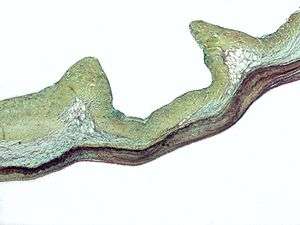Myxomatous degeneration

Myxomatous degeneration refers to a pathological weakening of connective tissue. The term is most often used in the context of mitral valve prolapse, which is known more technically as "myxomatous mitral valve degeneration." The word has its origin in the combining form myxo- (relating to connective tissue)[1]
The degeneration occurs in conjunction with an accumulation of dermatan sulfate, a glycosaminoglycan, within the connective tissue matrix of the valve. The exact mechanism is unknown.
In many cases, the degeneration is limited to the mitral valve and follows a benign course. When associated with systemic diseases, like Marfan syndrome, the degeneration is more extensive and involves other heart valves. The valves can become sufficiently distorted to cause insufficiency and regurgitation. Myxomatous degeneration is the most common cause of pure mitral valve insufficiency.
See also
References
- ↑ "etymology". wiktionary.
- Cotran RS, Kumar V, Fausto N, Nelso F, Robbins SL, Abbas AK (2005). Robbins and Cotran pathologic basis of disease (7th ed.). St. Louis, Mo: Elsevier Saunders. ISBN 0-7216-0187-1.